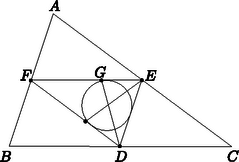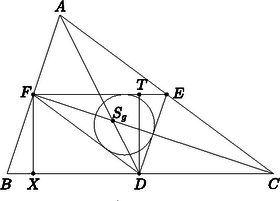| Cím: | The centre of gravity of a triangle | ||
| Szerző(k): | Imre Légrádi | ||
| Füzet: | 2003/októberi melléklet, 51 - 53. oldal |  PDF | MathML PDF | MathML |
|
| Témakör(ök): | Szakmai cikkek | ||
|
A szöveg csak Firefox böngészőben jelenik meg helyesen. Használja a fenti PDF file-ra mutató link-et a letöltésre. If the distribution of mass is considered, there are three different configurations that we can call triangle. Zero-dimensional triangles consist of three non-collinear pointlike objects of finite masses. Three thin rods of uniform mass distribution form a one-dimensional triangle. Finally, a two-dimensional triangle is a thin triangular sheet of uniform mass distribution. It is true for each of the three types of triangle that if it is situated on the surface of the Earth and its size is small relative to the radius of the Earth then its centre of gravity coincides with its centre of mass.  Consider a triangle that consists of such rods of uniform cross-sectional area, equal density and uniform mass distribution. Let the lengths of the sides be , and where (Figure 1). The procedure of finding the centre of mass can be reduced to the zero-dimensional case. The centre of mass of each side (rod) is at its midpoint, and the corresponding mass is proportional to the length of the side. Thus we can assume that there is a mass of at point , a mass of at point , and a mass of at point . The centre of mass of the resulting zero-dimensional triangle coincides with that of the original one-dimensional triangle. The centre of mass of the masses at and is the point of the line segment that divides in inverse ratio to the masses, that is, Thus the centre of mass of the zero-dimensional triangle lies on the angle bisector . Since we could have also started with the point masses and concentrated at the points and , and obtained that the centre of mass of the zero-dimensional triangle lies on the angle bisector of the angle at , the centre of mass must be the intersection of the angle bisectors, that is, the centre of the inscribed circle of the triangle . Therefore, the centre of mass of the one-dimensional triangle is not the centroid defined in geometry but the centre of the inscribed circle of the triangle of midlines. It is also known from geometry that the centroid of a triangle is closest to the longest side. It can be shown that the centre of mass of the one-dimensional triangle is also closest to the longest side. What is more, we shall prove below that the centre of mass of the one-dimensional triangle is closer to the longest side (if there is a longest side) than the intersection of the medians of the triangle, i.e. the centroid defined in geometry, and the two distances are only equal if the triangle is equilateral.  Figure 2 shows two medians ( and ) of the triangle , the centroid , and the altitude drawn to the longest side of the triangle of midlines. It is known from geometry that the radius of the incircle of the triangle is where is the area of the triangle and is half the perimeter. Thus We have seen that the centre of mass of the original one-dimensional triangle is at a distance of from the longest side . The distance of the centroid from the same side is , since medians divide each other in a ratio. We state, therefore, that . To prove this, substitute the expression It can be proved similarly that the centre of mass of the one-dimensional triangle is farther away from the shortest side than the centroid. As for the middle side , the centre of mass of the one-dimensional triangle may be farther away or closer than the centroid, or the two distances may even be equal if . That was the case in problem 4, category II of the Hungarian National Competition in Physics, 2000/2001. Here is the problem: The sides , , of a right-angled triangle are thin rods of the same material, with rigid joints at the vertices. The triangle is in a vertical plane, its side lying on a horizontal surface. The triangle falls from this unstable equilibrium. Find the speed of the vertex when it strikes the horizontal surface, given that the triangle does not slide while falling. (The triangle can turn without friction about the fixed side .) Where and with what speed would the vertex strike the horizontal surface if the side were free to slide and all friction were negligible? An interesting generalization of the problem is obtained by considering a zero-dimensional tetrahedron of four point masses, a one-dimensional tetrahedron constructed out of thin rods, a two-dimensional one made of thin plates, and finally a solid three-dimensional tetrahedron. Finding the centres of mass of these configurations is left to the reader as an exercise. |